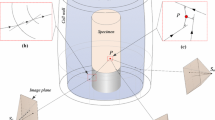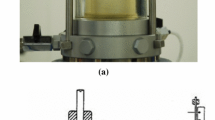Abstract
Discrete measurement targets were frequently utilized in image-based methods on the specimen’s surface to monitor the soil specimen during triaxial testing. However, the required density of measurement targets that should be used in triaxial testing to achieve highly accurate volume measurement has not been investigated. To overcome this limitation, this paper presents a parametric study to determine the optimum target/point densities to be utilized on the triaxial soil specimen surface to achieve the desired level of volume measurement accuracy in image-based methods. LiDAR scanning was applied to establish the “ground truth” volume of the specimen. The effects of deformation and failure modes were investigated by calculating the volume measurement accuracy at different strain levels and for different undisturbed soil specimens of clay and sand with silt. An interpolation method was proposed to increase the number of discrete targets representing the triaxial specimen’s surface. The analysis results show that a higher target density is required at a larger strain. Also, adding the number of interpolation points can only increase the accuracy to a certain level. As the volume measurement accuracy was different for each of the clay and sand with silt specimens, the non-uniform deformation, and failure mode of the specimen can affect the required optimum density of discrete measurement targets. In conclusion, it is recommended to choose the optimum density of targets based on the accuracy requirement, the maximum soil deformation level, and the expected failure mode of the specimen.












Similar content being viewed by others
References
Alshibli KA, Sture S (1999) Sand shear band thickness measurements by digital imaging techniques. J Comput Civil Eng 13(2):103–109. https://doi.org/10.1061/(ASCE)0887-3801(1999)13:2(103)
Alshibli KA, Al-Hamdan MZ (2001) Estimating volume change of triaxial soil specimens from planar images. Comput-Aided Civ Infrastruct Eng 16(6):415–421. https://doi.org/10.1111/0885-9507.00243
Bhandari AR, Powrie W, Harkness RM (2012) A digital image-based deformation measurement system for triaxial tests. Geotech Test J 35(2):1–18. https://doi.org/10.1520/GTJ103821
Fayek S, Xia X, Li L, Zhang X (2020) Photogrammetry-based method to determine the absolute volume of soil specimen during triaxial testing. Transp Res Rec 2674(8):206–218. https://doi.org/10.1177/0361198120928339
Fayek S, Zhang X, Galinmoghadam J, Xia X (2022a) Evaluating the effects of specimen misalignment during triaxial testing using a photogrammetry-based method. IEEE Trans Intell Transp Syst. (Under Review)
Fayek S, Xia X, Zhang X (2022b) Consideration of one camera photogrammetry-based method to reevaluate some aspects of conventional triaxial methods. Paper presented at the Proceedings of the Geo-Congress: State of the Art & Practice in Geotechnical Engineering, Charlotte, North Carolina March 20–23, 2022. American Society of Civil Engineers (Tentatively Accepted)
Fayek S, Xia X, Zhang X (2022c) Validation of photogrammetry-based method to determine the absolute volume of unsaturated soils. Paper presented at Advances in Transportation Geotechnics IV, Lecture Notes in Civil Engineering 165, pp. 773–781, Springer, Cham. https://doi.org/10.1007/978-3-030-77234-5_63
Gachet P, Geiser F, Laloui L, Vulliet L (2007) Automated digital image processing for volume change measurement in triaxial cells. Geotech Test J 30(2):98–103. https://doi.org/10.1520/GTJ100309
Gesch KR, Wells RR, Cruse RM, Momm HG, Dabney SM (2015) Quantifying uncertainty of measuring gully morphological evolution with close-range digital photogrammetry. Soil Sci Soc Am J 79(2):650–659. https://doi.org/10.2136/sssaj2014.10.0396
Gordon S, Lichti D, Stewart M (2001) Application of a high-resolution, ground-based laser scanner for deformation measurements. Paper presented in Proceedings of 10th International FIG Symposium on Deformation Measurements, pp. 23–32
Kikkawa N, Nakata Y, Hyodo M, Murata H, Nishio S (2006) Three-dimensional measurement of local strain using digital stereo photogrammetry in the triaxial test. In: Hyodo M, Murata H, Nakata Y (eds) Geomechanics and geotechnics of particulate media. Taylor and Francis, London, pp 61–67
Li L, Li P, Cai Y, Lu Y (2021) Visualization of non-uniform soil deformation during triaxial testing. Acta Geotech 16:3439–3454. https://doi.org/10.1007/s11440-021-01310-w
Lin H, Penumadu D (2006) Strain localization in combined axial-torsional testing on kaolin clay. J Eng Mech 132(5):555–564. https://doi.org/10.1061/(ASCE)0733-9399(2006)132:5(555)
Macari EJ, Parker JK, Costes NC (1997) Measurement of volume changes in triaxial tests using digital imaging techniques. Geotech Test J 20(1):103–109. https://doi.org/10.1520/GTJ11424J
Parker JK (1987) Image processing and analysis for the mechanics of granular materials experiment. In: ASME proceedings of the 19th SE symposium on system theory, Nashville, TN, March 2, 1987, ASME, New York
Quinsat Y (2015) Filling holes in digitized point cloud using a morphing-based approach to preserve volume characteristics. Int J Adv Manuf Syst 81(1):411–421. https://doi.org/10.1007/s00170-015-7185-0
Rechenmacher AL (2006) Grain-scale processes governing shear band initiation and evolution in sands. J Mech Phys Solids 54(1):22–45. https://doi.org/10.1016/j.jmps.2005.08.009
Rechenmacher AL, Medina-Cetina Z (2007) Calibration of soil constitutive models with spatially varying parameters. J Geotech Geoenviron Eng 133(12):1567–1576. https://doi.org/10.1061/(ASCE)1090-0241(2007)133:12(1567)
Sachan A, Penumadu D (2007) Strain localization in solid cylindrical clay specimens using digital image analysis (DIA) technique. Soils Found 47(1):67–78. https://doi.org/10.3208/sandf.47.67
Salazar SE, Coffman RA (2015) Consideration of internal board camera optics for triaxial testing applications. Geotech Test J 38(1):40–49. https://doi.org/10.1520/GTJ20140163.ISSN0149-6115
Salazar SE, Coffman RA (2015) Discussion of ‘a photogrammetry-based method to measure total and local volume changes of unsaturated soils during triaxial testing’ by Zhang et al. Acta Geotech 10(5):693–696. https://doi.org/10.1007/s11440-015-0380-1
Uchaipichat A, Khalili N, Zargarbashi S (2011) A temperature controlled triaxial apparatus for testing unsaturated soils. Geotech Test J 34(5):424–432. https://doi.org/10.1520/GTJ103586
White DJ, Take WA, Bolton MD (2003) Soil deformation measurement using particle image velocimetry (PIV) and photogrammetry. Géotechnique 53(7):619–632. https://doi.org/10.1680/geot.2003.53.7.619
Xia X, Zhang X, Fayek S, Yin Z (2021) A table method for decoding of coded target decoding with application to three-dimensional 3D reconstruction measurement of soil samples during triaxial testing. Acta Geotech 16(12):1–13. https://doi.org/10.1007/s11440-021-01343-1
Yang F, Su D, Ma Y, Feng C, Yang A, Wang M (2017) Refraction correction of airborne LiDAR bathymetry based on sea surface profile and ray tracing. IEEE Trans Geosci Remote Sens 55(11):6141–6149. https://doi.org/10.1109/TGRS.2017.2721442
Zhang X, Li L, Chen G, Lytton R (2015) A photogrammetry-based method to measure total and local volume changes of unsaturated soils during triaxial testing. Acta Geotech 10(1):55–82. https://doi.org/10.1007/s11440-014-0346-8
Zhao C, Koseki J (2020) An image-based method for evaluating local deformations of saturated sand in undrained torsional shear tests. Soils Found 60(3):608–620. https://doi.org/10.1016/j.sandf.2020.02.012
Author information
Authors and Affiliations
Corresponding author
Additional information
Publisher's Note
Springer Nature remains neutral with regard to jurisdictional claims in published maps and institutional affiliations.
Rights and permissions
About this article
Cite this article
Fayek, S., Zhang, X., Galinmoghadam, J. et al. Point density for soil specimen volume measurements in image-based methods during triaxial testing. Acta Geotech. 18, 5661–5679 (2023). https://doi.org/10.1007/s11440-023-02052-7
Received:
Accepted:
Published:
Issue Date:
DOI: https://doi.org/10.1007/s11440-023-02052-7




